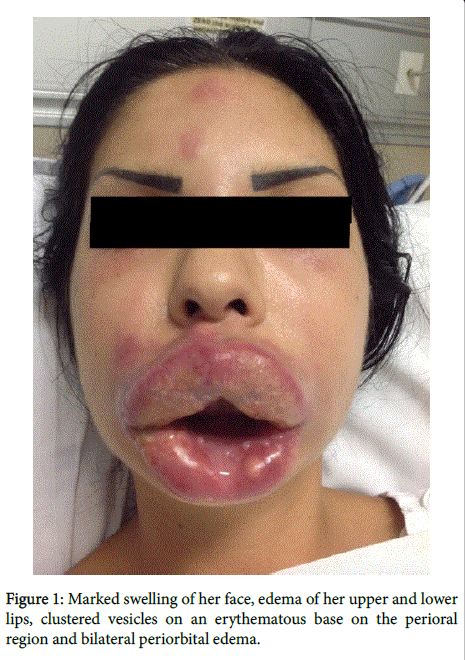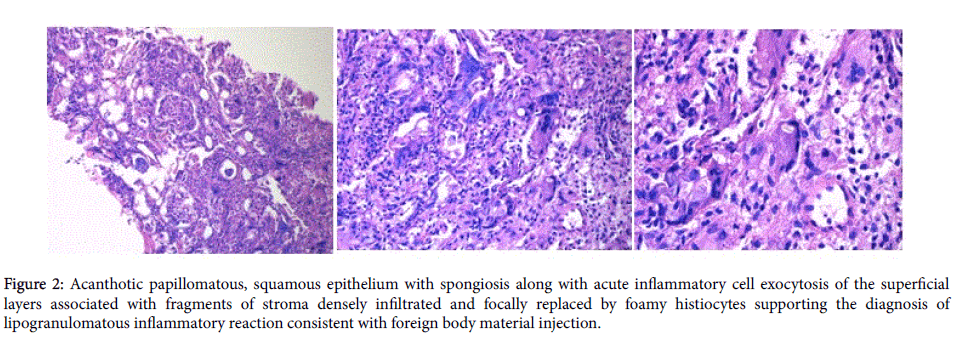Journal of Clinical & Experimental Dermatology Research
Open Access
ISSN: 2155-9554
ISSN: 2155-9554
Case Report - (2019)Volume 10, Issue 2
Cosmetic procedures are growing in number and demand. Herein, we present a case of Sclerosing lipogranulomatosis following self-injection of fish oil in lips and face with emphasis on the severity of the case, the importance of fast diagnosis and treatment.
Sclerosing lipogranulomatosis; Fish oil injection
We report a case of a 34-year-old female patient who presented to the hospital for severe facial swelling. Her past medical history was negative in particular regarding sarcoidosis. During her work as a beautician, she injected the contents of oral fish oil capsules, seven days prior to her presentation, into her lips as well as the face near the glabella and eyebrows. This was the first time she injects herself with fish oil product.
On physical examination, she had marked swelling of her face, edema of her upper and lower lips, clustered vesicles on an erythematous base on the perioral region and bilateral periorbital edema that worsened progressively in severity (Figure 1). She had a complete decrease in the range of motion of her lips. No neck swelling, however, she reported sore throat without respiratory compromise.

Figure 1: Marked swelling of her face, edema of her upper and lower lips, clustered vesicles on an erythematous base on the perioral region and bilateral periorbital edema.
The main differential diagnosis was granulomatous reaction to fish oil with superimposed herpetic infection versus facial cellulitis, which was less likely due to the absence of systemic signs of infection.
Therefore, polymerase chain reaction (PCR) for herpes simplex virus (HSV1 and 2) was taken from the upper lip lesions with bacterial culture sample and two deep upper lip mucosal punch biopsies after a signed consent. Meanwhile, the patient was admitted to the intensive care unit and kept nothing per mouth but received total parenteral nutrition. Her treatment involved intravenous (IV) steroids, IV antihistamines, empirical IV acyclovir, in addition to painkillers, sedatives and topical mupirocin. Her laboratory workup showed mild leukocytosis, negative eosinophil count, negative herpes Viridae and enteroviruses PCR panels with normal chemistry panel and bacterial cultures showed no growth after 1 week of incubation. Computerized Tomography (CT) scan of the face showed marked swelling of the subcutaneous tissue and fat overlying the maxillary and mandibular region associated with diffuse infiltration of the fat by a phlegmon-like reaction but no definite abscess cavity was seen.
Biopsies showed acanthotic papillomatous, squamous epithelium with spongiosis along with acute inflammatory cell exocytosis of the superficial layers associated with fragments of stroma densely infiltrated and focally replaced by foamy histiocytes supporting the diagnosis of lipogranulomatous inflammatory reaction consistent with foreign body material injection (Figure 2). Therefore, the patient was kept on systemic steroids therapy due to the inflammatory nature of the condition, her facial edema decreased gradually over few days and she was started on diet and discharged few days later.

Figure 2: Acanthotic papillomatous, squamous epithelium with spongiosis along with acute inflammatory cell exocytosis of the superficial layers associated with fragments of stroma densely infiltrated and focally replaced by foamy histiocytes supporting the diagnosis of lipogranulomatous inflammatory reaction consistent with foreign body material injection.
Predominantly, fish oil is known for its oral use. The components of fish oil capsules are Omega-3, eicosapentaenoic acid (EPA) and docosahexaenoic acid. Historically, it showed various health benefits; however, subcutaneous injections benefits were never reported [3,4]. In our patient, fish oil was injected as a mean to augment her lips, leading to inflammation and necrosis.
Gersuny was the first one to report, a century ago, the use of mineral oil injection for cosmetic reconstruction where liquid paraffin was injected into the scrotum of a young man after bilateral orchiectomy secondary to tuberculosis epididymitis [5]. Reports are available for many substances that have been injected by doctors or layers. such as mineral oil, automobile transmission fluid, ivory balls, vegetable oils, lanolin, beeswax, silk fabric, ground rubber, rubber, goat's milk, soybean, peanut oil and injectable silicone [6-8]. However, mostly a single response has been documented in literature to those injected agents and it was called Sclerosing Lipogranuloma (SL) by Smetana and Bernhard [9].
The use of substance injections by untrained personnel, rather than the product itself, always results in serious and more severe complications [10]. As reported by Omranifard and Taheri, the complications of injections can be categorized into 3 groups [10,11]:
1. Early (less than 14 days after application) which consists of erythema, edema, necrosis, immediate allergic reaction, infection at the injection site.
2. Late which consists of late allergic reactions, granulomas, filler migration, hypertrophic scars & telangiectasia.
3. Delayed consisting of granuloma formation.
In our case report, the granuloma formation was seen few days after injection although in most reported cases, such complications are seen few months later. This can be due to the fact that fish oil is not considered as certified dermal filler, although its use for augmentation has been reported minimally in the literature [4]. In addition, because fish oil is liposoluble, it needs oil product as a vehicle, which can be the etiology of granuloma formation [10].
Two types of SL exist: primary and secondary. Primary SL is idiopathic and is usually painless, whereas secondary SL is usually painful and primarily induced by injection of foreign materials such as paraffin and mineral oil [12,13].
Biopsy is the standard for diagnosis for SL and our case was typical of the histology [12]. Aside from eosinophilia, blood workup is usually normal in SL [12]. MRI is the most valuable imaging for demarcating the area of soft tissue involvement [14].
Regarding the treatment, we think that surgery should be preserved for recurrent or refractory cases when steroids have failed as first-line treatment. Systemic broad-spectrum antibiotic such as ceftriaxone can be administered because in such complications, superimposed infections should always be suspected. In addition, systemic steroids in a dose of 0.5-0.7 mg/kg with tapering within the next 6 to 8 weeks must be used, especially in a severe case like ours.
Citation: Bachour J, Sakkal M, Afif C, Ammoury A (2019) A Case Report of Sclerosing Lipogranulomatosis following Fish Oil Injection in Lips . J Clin Exp Dermatol Res 10: 492. doi:10.4172/2155-9554.1000492
Received: 27-Jan-2019 Accepted: 18-Mar-2019 Published: 26-Mar-2019
Copyright: © 2019 Bachour J, et al. This is an open-access article distributed under the terms of the Creative Commons Attribution License, which permits unrestricted use, distribution and reproduction in any medium, provided the original author and source are credited.